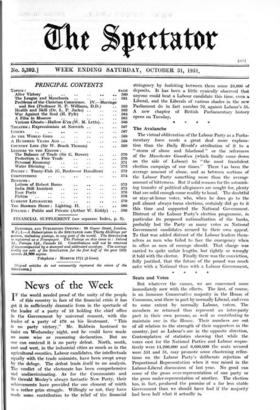Seats and Votes But whatever the causes, we are concerned
more immediately now with the effects. The first, of course, is an immense Conservative majority in the House of Commons, sent there in part by normally Liberal, and even to some extent by normally Labour, voters. The members so returned thus represent an inter-party pact in their own persons, as well as contributing to maintain one in the House. Their numbers are out of all relation to the strength of their supporters in the country, just as Labour's are in the opposite direction. Contemplation of statistics showing that while the votes cast for the National Parties and Labour respec- tively were 14,200,000 and 6,600,000 the seats secured were 551 and 51, may promote some chastening reflec- tions on the Labour Party's deliberate rejection of Proportional Representation when it was raised in the Labour-Liberal discussions of last year. No good can come of the gross over-representation of one party or the gross under-representation of another. The election has, in fact, produced the promise of a far less stable Government than we should have had if the majority had been half what it actually is.






































